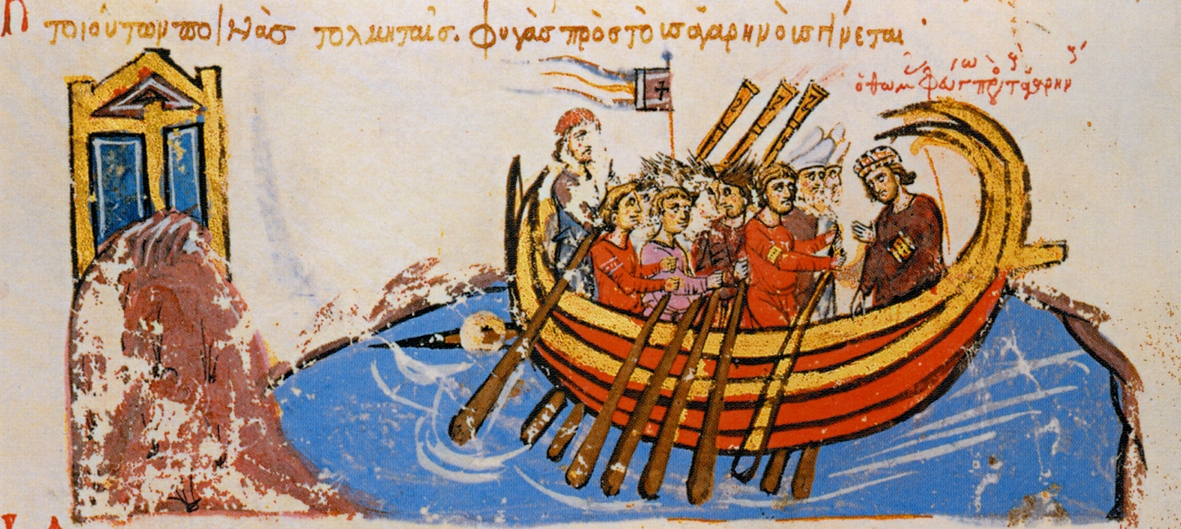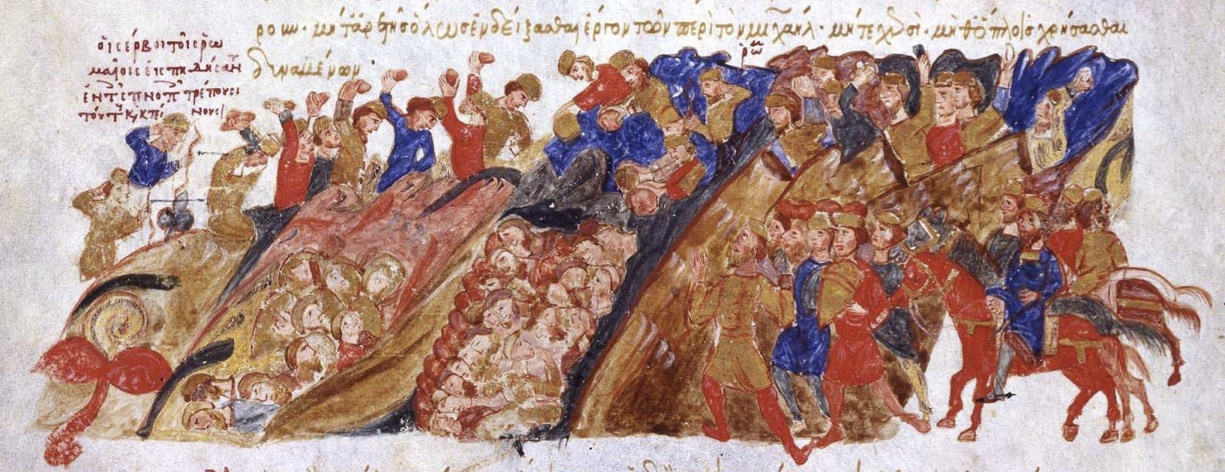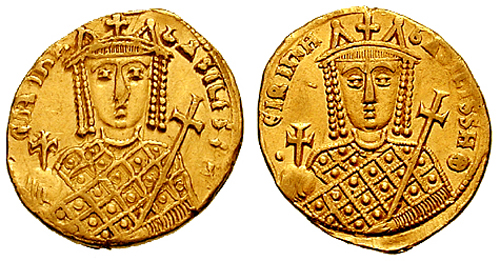|
Thomas The Slav
Thomas the Slav ( gr, Θωμᾶς ὁ Σλάβος, Thōmas ho Slavos, – October 823) was a 9th-century Byzantine military commander, most notable for leading a wide-scale revolt in 821–23 against Emperor Michael II the Amorian (). An army officer of Slavic origin from the Pontus region (now north-eastern Turkey), Thomas rose to prominence, along with the future emperors Michael II and Leo V the Armenian (), under the protection of general Bardanes Tourkos. After Bardanes' failed rebellion in 803, Thomas fell into obscurity until Leo V's rise to the throne, when Thomas was raised to a senior military command in central Asia Minor. After the murder of Leo and usurpation of the throne by Michael the Amorian, Thomas revolted, claiming the throne for himself. Thomas quickly secured support from most of the themes (provinces) and troops in Asia Minor, defeated Michael's initial counter-attack and concluded an alliance with the Abbasid Caliphate. After winning over the mar ... [...More Info...] [...Related Items...] OR: [Wikipedia] [Google] [Baidu] |
Madrid Skylitzes
The ''Madrid Skylitzes'' is a richly illustrated illuminated manuscript of the ''Synopsis of Histories'' ( el, Σύνοψις Ἱστοριῶν, ), by John Skylitzes, which covers the reigns of the Byzantine emperors from the death of Nicephorus I in 811 to the deposition of Michael VI in 1057. The manuscript was produced in Sicily in the 12th century, and is now at the Biblioteca Nacional de España in Madrid, with the shelfmark MS Graecus Vitr. 26–2. Other names for it are and . Apart from the very fragmentary 6th-century Alexandrian World Chronicle, it is the only surviving illustrated manuscript of a Greek chronicle, and includes 574 miniatures. It is unclear whether these illustrations are copies of earlier Byzantine images or were newly created specifically for this copy. Bibliography * Color facsimile edition by Militos (Μίλητος) Publishers, . * Vasiliki Tsamakda, The Illustrated Chronicle of Ioannes Skylitzes, Leiden 2002. * Bente Bjørnholt and J. Bur ... [...More Info...] [...Related Items...] OR: [Wikipedia] [Google] [Baidu] |
Bardanes Tourkos
Bardanes, nicknamed ''Tourkos'', "the Turk" ( gr, Βαρδάνης ὁ Τοῦρκος, Bardanēs ho Tourkos, ), was a Byzantine general of Armenian origin who launched an unsuccessful rebellion against Emperor Nikephoros I () in 803. Although a major supporter of Byzantine empress Irene of Athens (), soon after her overthrow he was appointed by Nikephoros as commander-in-chief of the Anatolian armies. From this position, he launched a revolt in July 803, probably in opposition to Nikephoros's economic and religious policies. His troops marched towards Constantinople, but failed to win popular support. At this point, some of his major supporters deserted him and, reluctant to engage the loyalist forces in battle, Bardanes gave up and chose to surrender himself. He retired as a monk to a monastery he had founded. There he was blinded, possibly on Nikephoros's orders. Origin and early career Nothing is known of the early life of Bardanes. He is usually regarded by modern scholar ... [...More Info...] [...Related Items...] OR: [Wikipedia] [Google] [Baidu] |
Genesios
Genesius ( el, Γενέσιος, ''Genesios'') is the conventional name given to the anonymous Byzantine author of Armenian origin of the tenth century chronicle, ''On the reign of the emperors''. His first name is sometimes given as Joseph, combining him with a "Joseph Genesius" quoted in the preamble to John Skylitzes. Traditionally, he has been regarded as the son or grandson of Constantine Maniakes. Composed at the court of Constantine VII, the chronicle opens in 814, covers the Second Iconoclast period and ends in 886. It presents the events largely from the view of the Macedonian dynasty, though with a skew less marked than the authors of Theophanes Continuatus, a collection of mostly anonymous chronicles meant to continue the work of Theophanes the Confessor. The chronicle describes the reigns of the four emperors from Leo V down to Michael III in detail; and more briefly that of Basil I. It uses Constantine VII's ''Life of Basil'' as a source, though it appears to have ... [...More Info...] [...Related Items...] OR: [Wikipedia] [Google] [Baidu] |
Asia Minor Slavs
The Asia Minor Slavs were the historical South Slav communities relocated by the Byzantine Empire from the Balkans to Asia Minor (Anatolia). After Maurice's Balkan campaigns (582–602) and during the subduing of the Slavs in the Balkans in the 7th and the 8th centuries, large communities were forcefully relocated to Anatolia as military units to fight the Umayyad Caliphate. History 7th century The earliest evidence for a relocation of Slavs from the Balkans may be a seal dated to 650. In 658 and 688/9 the Byzantines invited groups of Slavic settlers to Bithynia. Constans II settled captured Slavs in Asia Minor, and 5,000 of these joined Abdulreman ibn Khalid in 664-665. There was a town in Bithynia known as Gordoservon, mentioned in 680–81, whose name possibly derived from the Serbs resettled there from the areas "around river Vardar" by Byzantine Emperor Constans II (r. 641–668), in the mid-7th century (in ca. 649 or 667). Justinian II (685-695) also settled as many as 3 ... [...More Info...] [...Related Items...] OR: [Wikipedia] [Google] [Baidu] |
Theophanes Continuatus
''Theophanes Continuatus'' ( el, συνεχισταί Θεοφάνους) or ''Scriptores post Theophanem'' (, "those after Theophanes") is the Latin name commonly applied to a collection of historical writings preserved in the 11th-century Vat. gr. 167 manuscript.Kazhdan (1991), p. 2061 Its name derives from its role as the continuation, covering the years 813–961, of the chronicle of Theophanes the Confessor, which reaches from 285 to 813. The manuscript consists of four distinct works, in style and form very unlike the annalistic approach of Theophanes.Kazhdan (1991), pp. 2061–2062 The first work, of four books consists of a series of biographies of the emperors reigning from 813 to 867 (from Leo the Armenian to Michael III). As they were commissioned by Emperor Constantine VII (r. 913–959), they reflect the point of view of the reigning Macedonian dynasty. The unknown author probably used the same sources as Genesios. The second work is known as the '' Vita Basilii'' (L ... [...More Info...] [...Related Items...] OR: [Wikipedia] [Google] [Baidu] |
Byzantine Greeks
The Byzantine Greeks were the Greek-speaking Eastern Romans of Orthodox Christianity throughout Late Antiquity and the Middle Ages. They were the main inhabitants of the lands of the Byzantine Empire (Eastern Roman Empire), of Constantinople and Asia Minor (modern Turkey), the Greek islands, Cyprus, and portions of the southern Balkans, and formed large minorities, or pluralities, in the coastal urban centres of the Levant and northern Egypt. Throughout their history, the Byzantine Greeks self-identified as '' Romans'' ( gr, Ῥωμαῖοι, Rhōmaîoi), but are referred to as "Byzantine Greeks" in modern historiography. Latin speakers identified them simply as Greeks or with the term Romei. The social structure of the Byzantine Greeks was primarily supported by a rural, agrarian base that consisted of the peasantry, and a small fraction of the poor. These peasants lived within three kinds of settlements: the ''chorion'' or village, the ''agridion'' or hamlet, and the ''proas ... [...More Info...] [...Related Items...] OR: [Wikipedia] [Google] [Baidu] |
Byzantine Iconoclasm
The Byzantine Iconoclasm ( gr, Εικονομαχία, Eikonomachía, lit=image struggle', 'war on icons) were two periods in the history of the Byzantine Empire when the use of religious images or icons was opposed by religious and imperial authorities within the Orthodox Church and the temporal imperial hierarchy. The First Iconoclasm, as it is sometimes called, occurred between about 726 and 787, while the Second Iconoclasm occurred between 814 and 842. According to the traditional view, Byzantine Iconoclasm was started by a ban on religious images promulgated by the Byzantine Emperor Leo III the Isaurian, and continued under his successors. It was accompanied by widespread destruction of religious images and persecution of supporters of the veneration of images. The Papacy remained firmly in support of the use of religious images throughout the period, and the whole episode widened the growing divergence between the Byzantine and Carolingian traditions in what was still ... [...More Info...] [...Related Items...] OR: [Wikipedia] [Google] [Baidu] |
Oxford Dictionary Of Byzantium
The ''Oxford Dictionary of Byzantium'' (ODB) is a three-volume historical dictionary published by the English Oxford University Press. With more than 5,000 entries, it contains comprehensive information in English on topics relating to the Byzantine Empire. It was edited by Alexander Kazhdan, and was first published in 1991.''The Oxford Dictionary of Byzantium'', Oxford University Press, New York and Oxford, 1991. Kazhdan was a professor at Princeton University who became a Senior Research Associate at Dumbarton Oaks, Washington, DC, before his death. He contributed to many of the articles in the Dictionary and always signed his initials ''A.K.'' at the end of the article to indicate his contribution. Description The dictionary is available in printed and e-reference text versions from Oxford Reference Online. It covers the main historical events of Byzantium, as well as important social and religious events. It also includes biographies of eminent political and literary perso ... [...More Info...] [...Related Items...] OR: [Wikipedia] [Google] [Baidu] |
Omurtag Of Bulgaria
Omurtag (or Omortag) ( bg, Омуртаг; original gr, Μορτάγων and Ομουρτάγ', Inscription No.64. Retrieved 10 April 2012.) was a Great Khan ('' Kanasubigi'') of Bulgaria from 814 to 831. He is known as "the Builder". In the very beginning of his reign he signed a 30-year peace treaty with the neighboring Byzantine Empire which remained in force to the end of his life. Omurtag successfully coped with the aggressive policy of the Frankish Empire to take Bulgaria's north-western lands and suppressed the unrest among several Slavic tribes. He made administrative reforms which increased the power and the authority of the central government. His reign was marked with a strong development of Bulgarian architecture with a number of significant construction projects. Rise to the throne After the death of Khan Krum there was a short period of political instability in the country. Some sources mention that Bulgaria was ruled by three nobles - "Dukum" (Δούκουμος ... [...More Info...] [...Related Items...] OR: [Wikipedia] [Google] [Baidu] |
Khan (title)
Khan ''khan/qan''; tr, han; Azerbaijani: ''xan''; Ottoman: ''han''; Old Turkic: ''kan''; Chinese: 汗 ''hán''; Goguryeo: 皆 ''key''; Buyeo: 加 ''ka''; Silla: 干 ''kan''; Gaya: 旱 ''kan''; Baekje: 瑕 ''ke''; Manchu: ; Persian: خان; Punjabi: ਖ਼ਾਨ; Hindustani: ख़ान or ख़ां (Devanagari), or ( Nastaleeq); Balochi: خان; Bulgarian: хан, ''khan''; Chuvash: хун, ''hun''; Arabic: خان; bn, খান or ) () is a historic Turko-Mongol title originating among nomadic tribes in the Central and Eastern Eurasian Steppe to refer to a chief or ruler. It first appears among the Rouran and then the Göktürks as a variant of khagan (sovereign, emperor) and implied a subordinate ruler. In the Seljuk Empire, it was the highest noble title, ranking above malik (king) and emir (prince). In the Mongol Empire it signified the ruler of a horde (''ulus''), while the ruler of all the Mongols was the khagan or great khan. The title subsequentl ... [...More Info...] [...Related Items...] OR: [Wikipedia] [Google] [Baidu] |
First Bulgarian Empire
The First Bulgarian Empire ( cu, блъгарьско цѣсарьствиѥ, blagarysko tsesarystviye; bg, Първо българско царство) was a medieval Bulgar- Slavic and later Bulgarian state that existed in Southeastern Europe between the 7th and 11th centuries AD. It was founded in 680–681 after part of the Bulgars, led by Asparuh, moved south to the northeastern Balkans. There they secured Byzantine recognition of their right to settle south of the Danube by defeatingpossibly with the help of local South Slavic tribesthe Byzantine army led by Constantine IV. During the 9th and 10th century, Bulgaria at the height of its power spread from the Danube Bend to the Black Sea and from the Dnieper River to the Adriatic Sea and became an important power in the region competing with the Byzantine Empire. It became the foremost cultural and spiritual centre of south Slavic Europe throughout most of the Middle Ages. As the state solidified its position in the ... [...More Info...] [...Related Items...] OR: [Wikipedia] [Google] [Baidu] |
Siege Of Constantinople
The following is a list of sieges of Constantinople, a historic city located in an area which is today part of Istanbul, Turkey. The city was built on the land that links Europe to Asia through Bosporus and connects the Sea of Marmara and the Black Sea. As a transcontinental city within the Silk Road, Constantinople had a strategic value for many empires and kingdoms who tried to conquer it throughout history. Originally known as Byzantium in classical antiquity, the first recorded siege of the city occurred in 510 BC by the Achaemenid Empire under the command of Otanes. Following this successful siege, the city fell under the rule of Persians until it won its independence again and, around 70 BC, it became part of the Roman Republic, which was succeeded by the Roman Empire. Despite being part of Rome, it was a free city until it became under siege by Septimius Severus between 193–196 and was partially sacked during the civil war. After it was captured by Constantine the G ... [...More Info...] [...Related Items...] OR: [Wikipedia] [Google] [Baidu] |






